Northern white rhinos are in trouble, even when we are not in the midst of a global pandemic. Nobody knows this more intimately than National Geographic photographer and author Ami Vitale, who has been photographing the sub-species since 2009. Vitale’s photo of Sudan, the last male northern white rhino on Earth was named ‘Photo of the Decade’ by National Geographic’s social media following. When Vitale said goodbye to Sudan, she thought she was documenting the end of a species. However, in a twist of fate, the image of Joseph Wachira saying goodbye to Sudan – an image documenting extinction – is the beginning of something hopeful. Following Sudan’s death, a consortium of scientists from Leibniz Institute for Zoo and Wildlife Research, Avantea Laboratory, Ol Pejeta Conservancy, Kenya Wildlife Service and Safari Park, and Dvur Kralove Zoo hatched an ambitious plan to save the northern white rhino. The collaborative team has successfully created three embryos utilizing eggs extracted from a living northern white rhino and the cryopreserved sperm of deceased northern white rhinos. The first two embryos were created in September, and the third was created in December, following another egg extraction procedure. These three embryos are currently being stored in liquid nitrogen, with the intention of transferring them into a surrogate southern white rhino mother at Ol Pejeta Conservancy in Kenya.
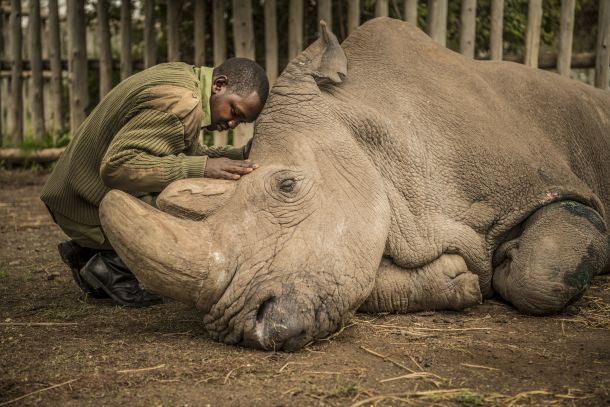
“Sudan’s death was not unexpected, yet it resonated with so many,” Vitale described. Photo by Ami Vitale.
In late March, as many African countries went on lockdown and wildlife safaris were postponed indefinitely, rhino poaching incidents have cropped up in travel hot spots previously protected by the presence of visitors and safari guides. A spike in rhino poaching in South Africa’s North West province left some experts worried that a drop in wildlife tourism due to COVID-19, will lead to an increase in wildlife casualties. “It’s a bloody calamity. It’s an absolute crisis,” Map Ives, founder of Rhino Conservation Botswana, a nonprofit organization, described in a recent interview about poaching across the continent.
“We imagine wildlife roaming the open plains of Africa freely,” Vitale said. “The reality is that they have to be guarded and protected around the clock, 24/7 by heavily militarized men.” Illegal poaching is one of the primary reasons that rhinos are so rare today, described Vitale. The horn is so valuable it can be sold on the black market for three times the price of gold. This pandemic is a reminder of just how small and deeply interconnected our world is, Vitale noted. “It is a moment to reimagine our relationship to nature and to each other.” During our interview, which has been edited and condensed, Vitale touched on the impact of photography on wildlife conservation, how COVID-19 is affecting the survival plan of the northern white rhino, and what the public can do to help support African wildlife conservancies and protect wildlife during the pandemic.
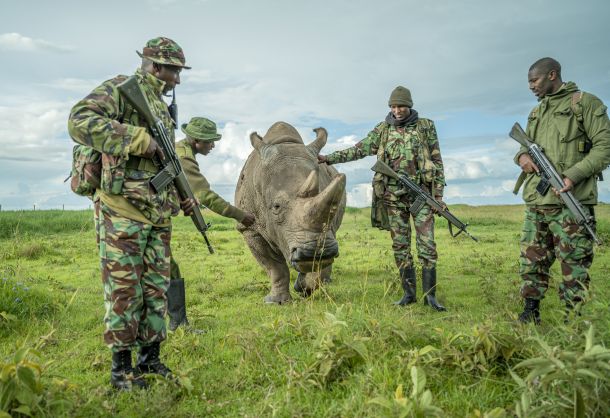
Najin and Fatu, the world’s last two remaining northern white rhinos, are protected by around the clock at Ol Pejeta Conservancy in Kenya. Photo by Ami Vitale.
Q: In the past you have said, “photography was my passport to meeting people, learning, and experiencing new cultures. Now it is more than just a passport. It’s a tool for creating awareness and understanding across cultures, communities and countries; a tool to make sense of our commonalities in the world we share.” How can these principles be applied to wildlife conservation?
Ami Vitale (AV): As a child I was painfully shy, gawky, and introverted. I was afraid of people and that made it difficult to engage with the world around me. Until I picked up a camera and then everything changed. It allowed me to shift the attention away from myself and focus on others. Looking through the viewfinder, I found a world full of wonder. Not only did photography enable me to see the world with fresh eyes, it allowed me to share and amplify other people’s stories and later, stories about wildlife and nature. I learned quickly that stories about the human condition cannot be separated from stories about the natural world. Our fates are linked. Losing one part of nature, is a loss for all of us. Photography has the unique ability to transcend all languages and help us understand our deep connections to one another and to all of life on this planet. It is the ultimate empathy tool for creating awareness and understanding across cultures; a tool for making sense of our commonalities in the world we share.
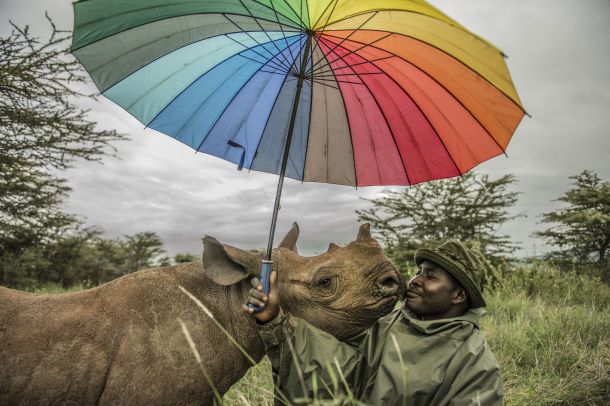
Kamara is nuzzled by black rhino Kilifi who he hand-raised along with two other baby rhinos at Lewa Wildlife Conservancy in Kenya. Kamara spends 12 hours every day watching over the vulnerable orphaned animals. This area was once home to one of the densest black rhino populations. Today, most locals have never seen a rhino in their life, despite it being the most perfect habitat for them. In just 2 generations this animal was poached almost to extinction. These communities and people like Kamara hold the key to saving Africa’s great animals. Photo by Ami Vitale.
AV: I want everyone to experience and benefit from the diversity of habitat and life we have today in all of its forms –- from glaciers to deserts, from elephants to the tiniest of ants that inhabit the earth. Without the diversity of life we have today, we will suffer more than just the loss of ecosystem health. We suffer a loss of imagination, a loss of wonder, a loss of beautiful possibilities. What happens next is in all of our hands. We must not fall into the trap of thinking that this issue is too big to deal with, or that someone else will take care of it. It is up to you. It is up to me. We need to make this story a priority. We all have the capacity to get engaged and use our voices to make a difference. Each of us can be a much more powerful voice when speaking to the people in our lives and if the camera is your tool of expression, use that to inspire others. Passionate storytellers change the world.
Q: As a photojournalist who travels the majority of the year, how are you coping with stay-at-home orders?
AV: Nature has sent us all a strong message and I’m thinking about that and embracing the stillness. This pandemic is a reminder of just how small and deeply interconnected our world is. It is a moment to reimagine our relationship to nature and to each other. My big takeaway is this: We all need to do all we can to care for the plants and critters that inhabit the earth. They are fellow travelers, and our only friends, in this cold dark universe. Our future happiness depends on them. This time is allowing me to work on the things I never had time to finish, to plant a garden and watch it grow, to rescue two animals, to nourish the people in my life and spend time really listening. I’m also working on a few fundraising campaigns for the communities in Kenya and the wildlife that is being hammered by this pandemic. Check out the Omaze campaign. A lucky couple will win a safari to Kenya and a private workshop with me, once it’s safe to travel. I’m also editing two films, a book project, an online photography course, planting a garden, endless Zoom calls and finding the stories I want to tell right now. Tomorrow, I’m starting a new project on how Montana is opening up, one of the first places to do so in the USA.
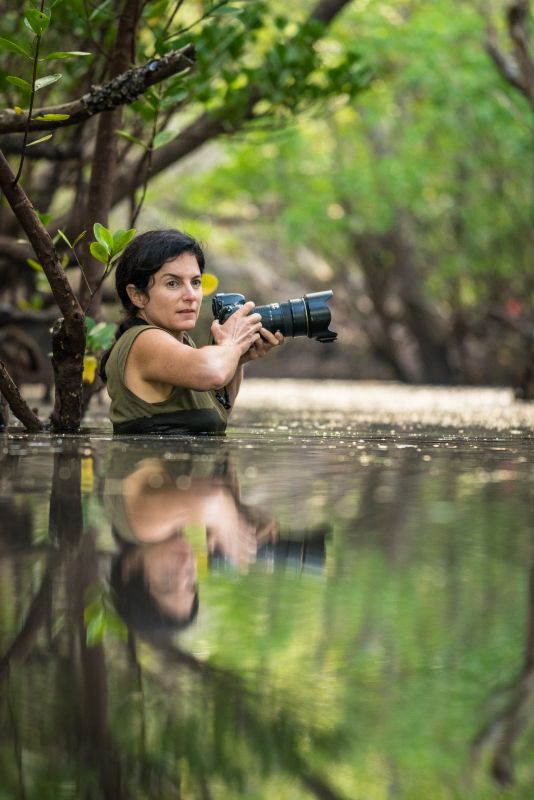
Ami Vitale on assignment in Kenya. Photo by Bryan Liscinsky.
Q: When you are in the field, what is it like photographing a species that is the last of its kind?
AV: I can recall the exact moment when I truly began to understand how profound our choices are and the impacts we have to one another and to all of life on this planet. It happened on a cold, snowy day in December 2009 in the village of Dvur Kralove in the Czech Republic. It was on this day that I met a rhino named Sudan for the first time. Quite unexpectedly, this animal changed the way I see the world forever. What surprised me was how connected I felt to the gentle, hulking creature sitting in front of me. When I got close to him, I had the strange feeling that I had just met a unicorn. He was mythical and otherworldly, larger than life. I recognized I was in the presence of a sentient, ancient creature. His species has been roaming the planet for millions of years and up until the last hundred years, there were possibly hundreds of thousands of them inhabiting the planet.
But on that day in 2009, there were only eight of these rhinos alive and they were all in zoos. I was there because there was a plan to airlift four of these last eight Northern White Rhinos from the zoo in the Czech Republic to Kenya. At first, I thought it was a story straight out of Disney cartoon but I quickly realized that this was a desperate, last ditch effort to save an entire species. When I saw these creatures, it seemed so incomprehensibly unfair that we had reduced them to this remnant of what they had been. For hundreds of years, rhino horn has been used by people around the world to treat illnesses, such as fever and stroke. Imbued by tradition with miraculous healing powers, rhino horn is actually just composed of keratin – the same material our fingernails and hair and made of. Nevertheless, today rhinos continue to be killed for their horns. We are witnessing extinction right now, on our watch. Poaching is not slowing down, and it’s entirely possible, even likely, that if the current trajectory of killing continues, elephants. rhinos, along with a host of lesser known plains animals will be functionally extinct in our lifetime.
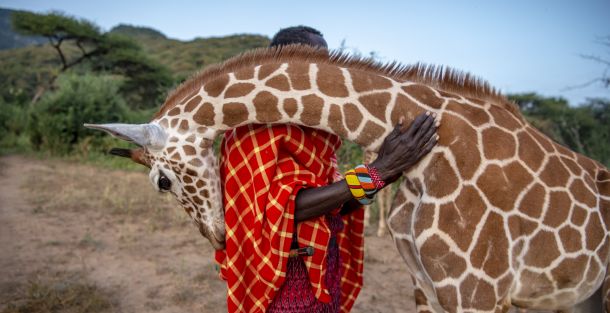
Giraffe embracing Lekupania. Photo by Ami Vitale.
Much needed attention has been focused on the plight of wildlife but very little has been said about the indigenous communities on the frontlines of the poaching wars. They hold the key to saving Africa’s great animals. The best protectors of these animals are the people who live alongside them. Human activity has placed 1 million plant and animal species in immediate danger of extinction, causing what scientists have identified as the the sixth major extinction event on this planet. This extinction event is different— not only is it driven by humans but it is happening at an incredibly fast and accelerating rate. Removal of a keystone species has huge effect in the ecosystem and impacts all of us. These giants are part of a complex world created over millions of years, and their survival is intertwined with our own survival. Without rhinos and elephants, and other wildlife, we all will suffer in ways we do not yet fully comprehend.
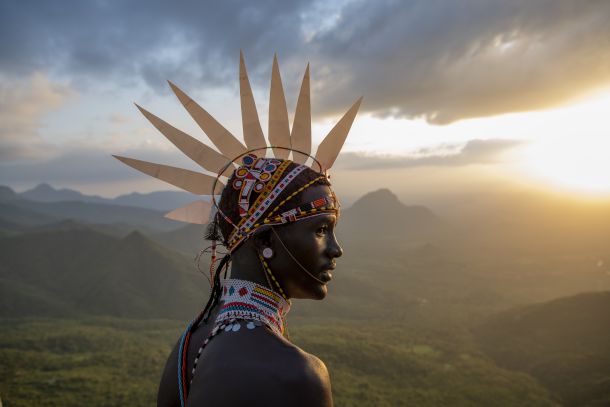
John Nkuus Leripe, of the Samburu tribe, watches the sun rise near Sarara Camp in northern Kenya. Photo by Ami Vitale.
AV: Flash forward to March 18th, 2018 when I received a call to hurry back to Kenya. I had made a number of trips to visit Sudan in his new home in Kenya but this time it would be different. This time I was traveling to Kenya to say goodbye to Sudan – goodbye to the last northern white male alive on the planet. To watch the last of something die is something I hope never to experience again. On the flight to Kenya, I worked through the many emotions I felt at the thought of saying good-bye to the Sudan that I had come to know over the last several years. I could employ my powers of rationalization and tell myself that he had a good and long life. I have lost those close to me before and as difficult and heart wrenching as it would be, I knew that I would slowly be able to come to terms with saying good-bye to Sudan. What I could not begin to wrap my mind around, what I could not come to terms with was the enormity of what it meant to say good-bye to species. Learning how to grieve a species may be a uniquely brutal and heartbreaking lessons that is specific to our generation. I arrived and Sudan was surrounded by the people who loved him and protected him. All I could hear was one bird wildly chirping against the backdrop of quiet, muffled sobs of his keepers. These men spend more time protecting these animals than they do with their own children. This gentle hulking creature survived for millions of years as a species, but he couldn’t survive us; he couldn’t survive mankind.
Q: Najin and Fatu are the last remaining northern white rhinos in the world. How are they faring at Ol Pejeta Conservancy during COVID-19? Are your local contacts at the Conservancy worried about increased wildlife poaching as a result of the drop in tourism?
AV: Najin and Fatu are safe and well protected 24/7. Visitor numbers are low even after re-opening, but Ol Pejeta is doing its utmost to continue in its attempts to save the northern white rhino. However, for many conservancies around the world, the consequences are severe. Tourism pays for the protection of wildlife and creates much needed income to people living side by side with wildlife. I am hearing that vast tracts of land are now vulnerable right through Africa due to poaching increasing in areas where all tourism has had to stop, leaving the areas unoccupied so sadly no income for the communities and no safari guides keeping a watch on the areas.
They are definitely seeing increased “chatter” and movement in known poaching gangs, as well as some petty snaring on both Ol Pejeta Conservancy and Mutara Conservancy – the latter is coming from local communities many of whom no longer have employment. The former is more worrying and reflects a perception that security capacity has been compromised by reduced incomes to Conservancies.
Q: After Sudan passed away in 2018, plans were put in place to try in-vitro fertilization to save the sub-species. In January, scientists in Italy revealed that they had successfully created three northern white rhino embryos. What are the crucial next steps in this process, and how is the pandemic affecting the white rhino reproduction plan?
AV: Unfortunately, world-wide travel restrictions prevented me from going to Kenya in April and May and the conservancy estimates that they “lost” possibly two embryos that might be developed from the oocytes likely collected during the procedure in Kenya, but we all hope that we will be able to resume our work in Kenya as soon as possible. However, the first step is to think about people and we want to visit the country only when it will be clear it is safe for its inhabitants. Researchers will be allowed to conduct the next collection of eggs in coming months, therefore the delay in the project will not destroy the project but there is an urgency to continue.
In the beginning of May, oocytes were collected from a female in Schwerin Zoo to allow BioRescue project to produce southern white rhino or hybrid embryos that will be used in the future for an embryo transfer attempt in European zoos. Experience gained during these procedures will directly enhance the chances of having a successful embryo transfer even with northern white rhino embryos in Kenya when time comes.
Apart from that, the BioRescue consortium is working on additional procedures to achieve northern white rhino embryos – through stem-cells. They are actively trying to overcome the hurdles that COVID-19 may pose for the project so that the project will not be completely on hold. They are still working to save the northern white rhino!
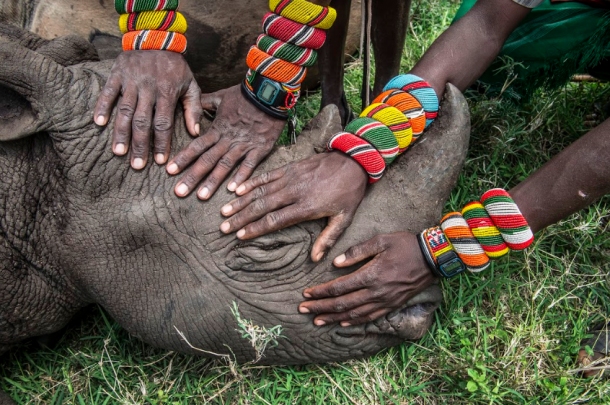
A group of young Samburu warriors touch a black rhino for the first time in their lives at the Lewa Wildlife Conservancy, in northern Kenya. Black rhinos are almost extinct in Kenya. This young calf had been orphaned when poachers killed its mother, and was hand-raised at Lewa. Photo by Ami Vitale.
Q: What kind of safety measures are your contacts undertaking when working in the field? Have they experienced staff reductions as a result of the pandemic?
AV: Ol Pejeta could have let go of tourism staff but instead everyone took a pay cut. So the burden is shared and hundreds of jobs were saved. Ol Pejeta is currently open for tourism. People can come for game drives and stay in their cars. There are also health measures being taken at the gate such as hand washing stations and hand sanitizer available. They are also doing everything possible to safeguard wildlife but they can only operate within the resources they have. Ol Pejeta’s overall income is now expected to fall by 50% for the year so it is inevitable – no matter how hard they try – operational capacity will suffer to some extent.
Q: If we see a loss of species such as rhinos and elephants, what effect do you think this will have on the wildlife tourism industry post-pandemic?
AV: I received this response from Ol Pejeta Conservancy: “I doubt we will see a total loss, but definitely some losses. It worries me that people will not be able to travel internationally and that there is an increasing narrative around people abandoning air travel to save the planet. I think what people need to understand is that tourism is what keeps Africa’s wildlife alive – so international travel is essential for that. Instead people should be travelling responsibly, to destinations that act to sustain wildlife areas, and choosing companies that put money back and are not wholly extractive.”
AV: Personally, I believe the pandemic has forced us to see how interconnected we are. While this revelation has been devastating, it’s also shown us how we are able to unite and act as individuals for the collective good. This is a moment when we can look outside ourselves and take individual action for the good of the planet. I am personally thinking about a different approach to my own work and my travel. Travel is important but I know that we must change how we travel. We can alleviate some of the environmental stress of travel simply by keeping more of our adventures local. Save your carbon budget for a more impactful trip. Rather than trying to see it all, slow down and really engage with one place at a time. Instead of travelling to many countries, think about spending time in one place in that same time frame. When we take the time to slow down and truly build real relationships with people and places, an authentic connection is created.
Q: What are some actions the public can take to help protect these critically endangered animals?
AV: Donate. Support a conservation project. Support wildlife conservancies. In Kenya, there are so many conservancies where you know your tourism dollars are going back into the same communities who are protecting habitat and wildlife. Become citizens of the Earth. People need to start acting responsibility and need to understand that taking care of this planet starts with every single one of us.
Postpone your trips. Urge people to not ask for refunds if they have a trip planned to Africa or Kenya. Ask them to book a trip for next year. They still need travel and tourism. It is one of the main drivers to protecting fragile habitats. When we do fly, purchase carbon offsets. You are not completely undoing all the harm, but they are better than nothing at all. There is a lot of ecotourism green-washing and we should be looking to travel to places with a transparent sustainability plan. When we are on the ground in a destination, we can reduce our footprint and be respectful by choosing sustainable activities. I’m working as an ambassador with the nonprofit TreadRight, which has developed a checklist to help travelers adopt these habits and be more conscious of our choices.
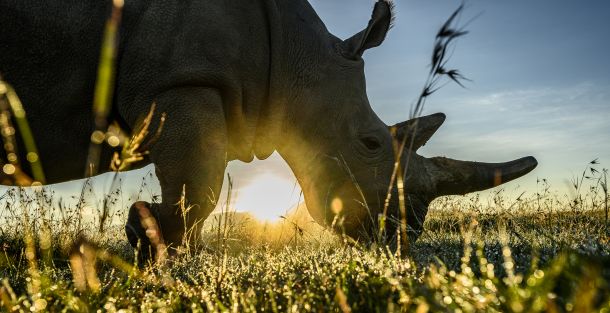
Photo by Ami Vitale.
